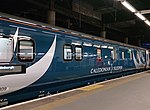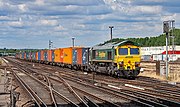British Rail Mark 1 is the family designation for the first standardised designs of railway carriages built by British Railways (BR) from 1951 until 1974...
32 KB (4,046 words) - 16:12, 17 August 2024
Mark 2 family of railway carriages are British Rail's second design of carriages. They were built by British Rail workshops (from 1969 British Rail Engineering...
23 KB (2,426 words) - 05:06, 8 August 2024
The British Rail Mark 3 is a type of passenger carriage developed in response to growing competition from airlines and the car in the 1970s. A variant...
41 KB (4,531 words) - 10:46, 13 October 2024
The British Rail Mark 5A is a type of railway vehicle in use in the UK. 52 standard carriages and 14 driving trailers were built by Spanish manufacturer...
12 KB (907 words) - 08:30, 22 September 2024
The British Rail Mark 4 is a class of passenger carriages built for use in InterCity 225 sets on the East Coast Main Line between King's Cross, Leeds...
17 KB (1,789 words) - 23:50, 16 June 2024
The British Rail Mark 5 is the designation given to locomotive-hauled rail carriages built by Spanish manufacturer CAF for operation with Caledonian Sleeper...
10 KB (951 words) - 15:08, 21 April 2024
British Rail Engineering Limited (BREL) was the rolling stock manufacturing and maintenance subsidiary of British Rail. It was established on 1 January...
19 KB (1,647 words) - 10:35, 16 August 2024
to the Class 201 (or 6S) they were built to the longer (63ft 5in) British Rail Mark 1 standard and therefore had 288 seats (240 second class plus 48 first...
9 KB (387 words) - 12:16, 9 April 2024
The impact of the privatisation of British Rail has been the subject of much debate, with the stated benefits including improved customer service, and...
77 KB (7,594 words) - 09:54, 2 October 2024
1985–87. They were the first of several classes of British Rail EMU to be based on the all-steel Mark 3 bodyshell, departing from the PEP-aluminium design...
41 KB (3,835 words) - 00:49, 6 October 2024
During the 2000s, the British train operating company Direct Rail Services (DRS) recognised that its small fleet of British Rail Class 20 diesel locomotives...
33 KB (2,696 words) - 12:04, 8 October 2024
The British Rail Class 150 Sprinter is a class of diesel-hydraulic multiple unit passenger trains, developed and built by British Rail Engineering Limited...
60 KB (5,761 words) - 01:15, 6 October 2024
introduced by British Rail in 1966 for its long-haul express passenger services (see British Rail brand names for a full history). In 1982, the British Railways...
33 KB (3,270 words) - 13:29, 9 September 2024
constructed with the British Rail Mark 2 bodyshell, as well as the last class of multiple unit to be built with slam doors in Britain. These features contributed...
17 KB (1,178 words) - 00:55, 24 August 2024
The British Rail Mark 5 is the designation given to the planned passenger rolling stock for the InterCity 250 project, a plan to improve speeds on the...
10 KB (1,236 words) - 11:18, 20 May 2023
unveil our latest class 66 newly renamed 'British Rail 1948-1997'. The loco marks the 70th anniversary of British Railways and is currently undergoing a...
90 KB (6,880 words) - 05:46, 19 October 2024
British Railways (BR), which from 1965 traded as British Rail, was a state-owned company that operated most rail transport in Great Britain from 1948...
103 KB (10,123 words) - 07:29, 20 September 2024
The privatisation of British Rail was the process by which ownership and operation of the railways of Great Britain passed from government control into...
57 KB (5,760 words) - 04:09, 10 October 2024
The British Rail Class 360 is an electric multiple unit class that was built by Siemens Mobility on its Desiro platform between 2002 and 2005 for First...
19 KB (1,514 words) - 00:31, 6 October 2024
the prototype High Speed Train (HST) with Mark 3 carriages. Two power cars were built in 1972 by British Rail Engineering Limited's Crewe Works, numbered...
9 KB (739 words) - 11:44, 17 January 2024
Great Britain British electric multiple units British railcars and diesel multiple units History by era History of rail transport in Great Britain to 1830...
62 KB (6,297 words) - 20:02, 13 October 2024
internal construction with much more in common with BR coaching stock (British Rail Mark 1) than they do with many DMU classes. The carriage underframes were...
7 KB (523 words) - 10:30, 14 October 2024
The British Rail Class 411 (4CEP) electric multiple units were built at Eastleigh works from 1956–63 for the newly electrified main lines in Kent. These...
33 KB (2,855 words) - 05:55, 26 August 2024
Class 317/318, as well as the diesel Class 150, they are based on the British Rail Mark 3, with a steel construction, unlike the earlier PEP based Class 313...
36 KB (3,172 words) - 02:30, 11 October 2024
The British Rail Double Arrow is a logo that was created for British Rail (BR), the then state-owned operator of Britain's railway network, in 1965. It...
7 KB (760 words) - 11:04, 23 April 2024
The British Rail Class 43 (HST) is the TOPS classification used for the InterCity 125 High Speed Train (formerly Classes 253 and 254) diesel-electric power...
65 KB (6,057 words) - 20:58, 20 September 2024
British Rail Class 37 is a diesel-electric locomotive. Also known as the English Electric Type 3, the class was ordered as part of the British Rail modernisation...
85 KB (8,599 words) - 13:58, 12 October 2024
InterCity 125 (redirect from British Rail class 253)
eight Mark 3 coaches. The name is derived from its top operational speed of 125 mph (201 km/h). At times, the sets have been classified as British Rail Classes...
93 KB (9,869 words) - 11:40, 7 October 2024
The British Rail Class 745 FLIRT is a class of electric multiple unit passenger train, built by Stadler as part of the FLIRT family. The class is built...
15 KB (1,022 words) - 14:37, 27 August 2024
The history of British Rail's corporate liveries is quite complex. Although the organisation was associated with Rail Blue from the mid-1960s to the 1980s...
30 KB (3,644 words) - 19:16, 26 September 2024



























